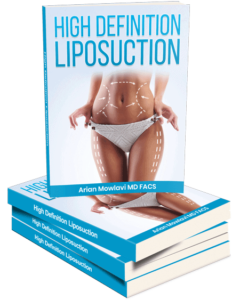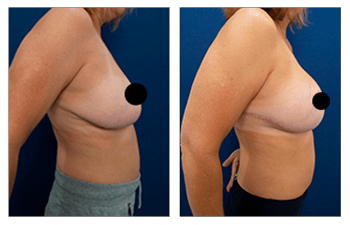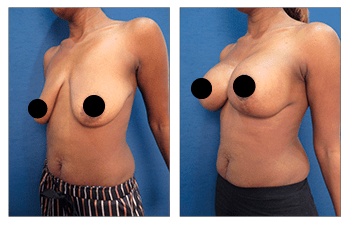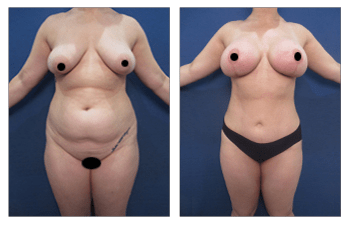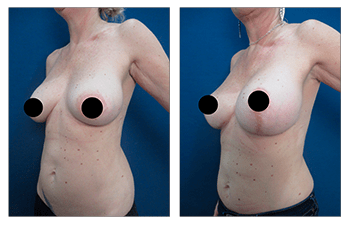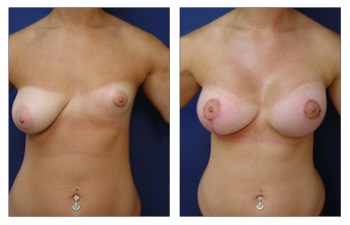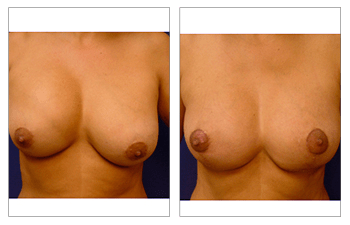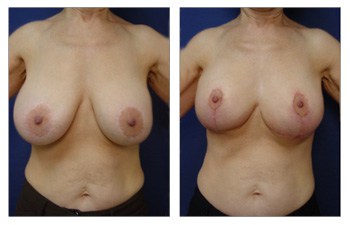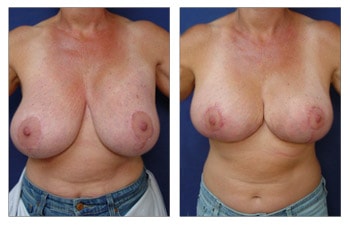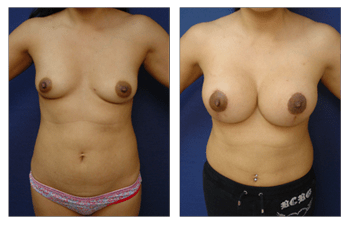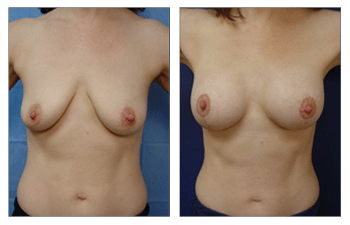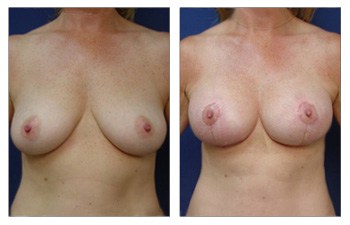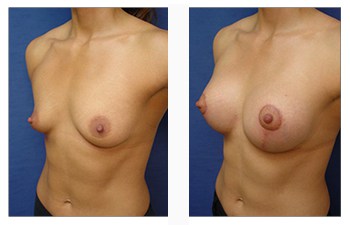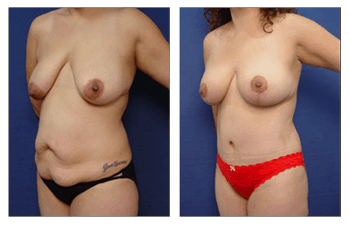WANT THE CONFIDENCE THAT COMES WITH
KNOWING YOU LOOK YOUR BEST?
Breast lift with implants CASE STUDIES
breast lift with implants CASE STUDIES
Breast lift with implants
Breast Lift with Implant Augmentation Natrelle™ focuses on improving breast appearance for patients who may be experiencing any one of the concerns below:
- Patients who have noticed slight drooping of their breasts due to the natural aging process.
- Patients who have noticed the loss of volume and drooping of their breasts following pregnancy and breastfeeding.
- Patients who have noticed the loss of volume and drooping of their breasts following weight loss.
- Patients who have previously undergone breast augmentation and noticed the dropping of their breast mounds off of their breast implants.
Cosmetic Surgeon Dr. Paris, located in beautiful Newport Beach, Orange County, is considered an expert of synchronous breast lift and augmentation and has developed Breast Lift with Implant Augmentation NatrelleTM to ensure that each patient attains their maximum potential following simultaneous breast lift and augmentation surgery. Breast Lift with Implant Augmentation Natrelle™ optimizes all aspects of your breast augmentation experience, including your initial confidential consultation, an anxiety-free operation, comfortable postoperative recovery, a speedy return to full activity, and long-term results.
During your initial consultation with Dr. Paris in Newport Beach, Orange County, you will have the opportunity to tell him exactly your concerns and for you and Dr. Paris to set your personal goals. Dr. Paris will complete a thorough history and physical, which will ensure your optimum results. Dr. Paris will examine your breasts and take detailed notes and measurements to ensure optimum breast lift with implant augmentation results.
Dr. Paris Orange County Breast Lift with Implant Augmentation examination will take into account several factors, including:
- Breast mound size and any asymmetry
- Nipple areola complex positioning and any asymmetry
- Medial cleavage fullness or lack of
- Lateral breast mound concavity
- Inframammary crease positioning and any asymmetry
- Breast mound diameter and chest wall width
- Nipple areola complex to inframammary crease distance and any asymmetry
- Breast skin and soft tissue thickness
- Pectoralis muscle tone and asymmetry
You will then enjoy trying on a full array of breast implant sizes to see and feel the look you are going for. Although you will have your patient coordinator helping you sift through the various implant size and shape options, Newport Beach Cosmetic Surgeon Dr. Paris encourages you to bring your significant other, family, and friends to help you choose the implant size that will achieve the look you are striving for following your Newport Beach Breast Lift with Implant Augmentation procedure.
As part of your Breast Lift with Implant Augmentation Natrelle™ experience, Newport Beach, Orange County surgeon Dr. Paris and your patient coordinator will spend ample time detailing the preoperative planning and preparation you require, your operative course and plan, and your postoperative recovery and expectations. These steps are critical to ensuring optimum breast augmentation results.
Preoperative planning for a Breast Lift with Implant Augmentation includes:
- Arranging for time off of work during your recovery period.
- Preparing meals and routine daily needs ahead of time.
- To wash with antimicrobial soap starting 4 days prior to surgery.
- Providing anti-anxiety medications on the night prior to as well as on the day of surgery.
- Planning for a responsible adult to accompany you to and from surgery and for the first 72 hours following surgery.
Breast Lift with Implant Augmentation Natrelle™ focuses on several operative measures that are taken by Dr. Paris to optimize your results.
- Use of only FDA approved breast implants made by Mentor and/or Allergan Corporation to ensure the longevity of your implants.
- Provide perioperative antibiotics through your IV to minimize the risk of infection.
- Utilize extended surgical drapes to ensure sterility throughout your case.
- Utilize nipple-areola shields in order to avoid contamination of your implants from endogenous bacteria that normally live within the breast glands.
- Use of a bi-planar surgical technique in order to allow for correction of slight nipple-areola and/or breast mound asymmetry.
- Use of anatomic landmarks for pectoralis muscle release in order to ensure the symmetric release of muscles and subsequent symmetry of proposed breast implants pocket position.
- Use of non-powdered gloves and subsequently irrigating gloves with antibiotics solution to avoid all irritants that could cause capsular contracture.
- Use of antibiotic solution to irrigate the surgical breast pocket and breast implants in addition to the surgeon’s gloves to minimize the risk of infection.
- Use of minimal touch technique when handling breast implants prior to implantation.
- Use of sterile breast implant sizes prior to committing you to your final breast implant.
- Maintaining an array of breast implant sizes and shapes on consignment at our surgery center so that adjustments in size can be considered during your operation should unexpected intraoperative findings be made.
- Placement of specialized breast garment, i.e. breast band, which maximizes maintenance of breast implant position and avoids implant malposition.
Finally, Breast Lift with Implant Augmentation Natrelle™ focuses on providing you a comfortable immediate postoperative period, speedy recovery, and long-lasting results.
- Use of long-lasting numbing solution instilled into your breast pocket prior to closing your incision lines so that you have a comfortable immediate postoperative recovery.
- Provide your superior grade anesthetic medications during your surgery in order to avoid postoperative nausea and grogginess.
- Provide you with generous bandages and garments that won’t have to be replaced until you dispense with them at your first postoperative visit.
- Educate you and train you to perform breast massage exercises, which will minimize the incidence of scar tissue formation, i.e. capsular contracture, and ensure long-term aesthetically pleasing breast shape.
Surgical Technique
Combining breast lift and augmentation surgeries is a mainstay of Newport Beach, Orange County surgeon Dr. Paris’s breast surgery expertise. Dr. Paris has developed Breast Lift with Implant Augmentation Natrelle™ to specifically meet the needs of patients who have developed breast and nipple-areola droop in addition to having lost volume. Dr. Paris has modified current breast lift and breast augmentation techniques in order to allow correction of deflated and droopy breasts in a single session, thus being termed: Breast Lift with Implant Augmentation.
Newport Beach, Orange County Cosmetic Surgeon Dr. Paris has modified the conventional vertical breast lift technique to make it conducive and safe to have a breast lift with implant augmentation performed simultaneously. Dr. Paris’s modifications include:
- Differential nipple-areola transposition
- Symmetric submuscular breast implant pocket positioning
- Differential medial and lateral breast mound tailoring
- Secondary in-setting of the nipple-areola complex
- Surgical incision line maintenance and scar prevention
Differential nipple-areola transposition during a Breast Lift with Implant Augmentation Procedure
Traditional vertical breast lift techniques describe transposing the nipple-areola to a higher, more attractive position. However, the optimal nipple-areola position has not been standardized; Newport Beach, Orange County Cosmetic Surgeon Dr. Paris utilizes several parameters to individualize the ideal nipple position for you. Previous descriptions have advocated positioning your nipple areola at or just above your inframammary crease line. Dr. Paris has modified this criterion based on your chest-to-torso height ratio. If you possess a generous chest height, then you will be more apt to tolerate a higher nipple-areola position; in contrast, if you have a short chest height, the nipple is placed closer to the inframammary crease line. In addition, Dr. Paris has modified conventional breast lift techniques to allow for the centralization of the nipple-areola when it points out (lateralized on your breast). This modification allows for the nipple-areola complex to be brought to the middle of your breast mound thus providing you cosmetically superior breast appearance.
Symmetric submuscular breast implant pocket positioning during a Breast Lift with Implant Augmentation Procedure
Following simultaneous breast lift and augmentation, providing symmetrical breast mound positions remains the mainstay of patient satisfaction. As such, Dr. Paris has developed anatomic landmarks that he utilizes to accurately release the pectoralis muscle when creating your breast implant pocket. In order to fit the breast implant into its appropriate pocket, the pectoralis muscle must be released from its attachments to the sternum. When performing this portion of the surgery, Dr. Paris utilizes specific landmarks in order to ensure the accurate and symmetric release of the muscle, thus ensuring symmetrically positioned breast implants and, subsequently aesthetically pleasing breast mounds.
Differential medial and lateral breast mound tailoring during a Breast Lift with Implant Augmentation Procedure
Following the transposition of your nipple-areola complex to the center of your breast mound and following the placement of your breast implant, the surgeon has to tailor the excess, undesired, and drooping breast skin and soft tissues. Dr. Paris has developed a technique of differentially removing these unwanted tissues from the medial and lateral breast tissues. Dr. Paris independently redrapes, trims, and secures each half (medial and lateral breast mound) in order to tailor your final breast appearance. Differential medial and lateral breast skin mound tailoring allows Dr. Paris to obtain a cosmetically superior breast mound appearance and better symmetry between the two breast mounds.
Secondary in the setting of the nipple-areola complex during a Breast Lift with Implant Augmentation Procedure
Since the nipple and areola complex is positioned in the center of your breast, Newport Beach, Orange County Surgeon Dr. Paris feels that its appearance is just as critical as the shape of and symmetry of your breast mounds. As such, Dr. Paris has modified traditional in the setting of the nipple-areola complex. Traditionally, the nipple-areola complex creation is the final step of a breast lift procedure. Creating the nipple-areola complex involves delivering the nipple and areola complex at the center of the mound and sewing it to the adjacent breast mound skin. Dr. Paris has observed that the shape of the nipple-areola complex is affected by the differential pull of the breast mound skin. For example, it is common to have looser upper lateral breast skin when compared to the medial breast skin even following a breast lift. Having looser skin over this region will result in the breast skin giving out and thus the upper lateral areola pulling medially, thus distorting the areola shape from an ideal circular shape. As such, Dr. Paris performs his initial nipple-areola in-setting towards the middle of surgery so that the variable pull of the breast skin on the areola can settle; towards the end of the surgery, Dr. Paris performs a secondary in-setting of the nipple-areola complex to ensure a circular shaped areola.
Surgical incision line maintenance and scar prevention from a Breast Lift with Implant Augmentation Procedure
Newport Beach, Orange County Surgeon Dr. Paris, and his staff are committed to providing you optimum healing of all surgical incision lines from your Breast Lift with Implant Augmentation procedure so that you can enjoy not only aesthetically shaped breast mounds but also aesthetically appearing breasts when not covered by undergarment wear. Dr. Paris has developed a scar prevention program that spans from the preoperative to perioperative and postoperative periods. Surgical incision line management starts with the placement of patients on preoperative/perioperative antibiotics to minimize the risk of infection. In addition,Dr. Paris advocates washing of the breasts with a specialized antimicrobial soap for four days prior to surgery. Also, Dr. Paris advocates a high protein diet to ensure optimum healing of surgical incision lines following surgery. During your operation, Dr. Paris repairs all incision lines in two to three layers in order to remove unwanted tension off of the surgical incision lines. Furthermore, all suture layers are performed internally in order to avoid all external stitches that can result in “hash” marks, i.e. railroad tracking when left in place for more than 10 days. In fact, Dr. Paris utilizes sutures, which remain in place for three months prior to being self-absorbed. Instead of external sutures, Dr. Paris utilizes a specialized medical-grade adhesive and medical tape, called Steri-Strips, to further reinforce the surgical incision line. Finally, Dr. Paris encourages an aggressive postoperative scar prevention program, which includes: maintenance of surgical tapes for one month, followed by Biocorneum silicone gel application to incision lines daily. The staff at Cosmetic Plastic Surgery Institute is devoted to ensuring well-healed surgical incision lines and will provide you further armamentarium when required.
Over the last few years, we have become as appreciative of the buttocks aesthetics as we have been of our breasts. Undeniably, the desirable female silhouette is defined as much by perky and robust breasts as it is by a tight waistline and well-balanced and prominent buttocks contour. Therefore many patients, who are considering breast surgery, are now also considering undergoing Newport Beach Buttocks Augmentation Surgery.
Mirzania, MD, FACS is a cosmetic surgeon, located in Newport Beach, Orange County, who has dedicated his practice to providing prospective patients the breast shape they deserve. Breast Lift with Implant Augmentation Natrelle™ is dedicated to restoring, lifting and augmenting breasts to their natural contour and youth full appearance.
Natrelle™ is a trademark of Allergan Corporation.
Frequently Asked Questions:
Am I a good candidate for breast lift surgery?
You may be a good candidate for breast lift surgery if you have: a)breasts that are pendulous, but of satisfactory size, b)breasts that lack substance or firmness, or c) nipples and areolas that point downward, especially if they are positioned below the breast crease (inframammary crease). The shape and firmness of your breasts may be affected by factors such as loss of skin elasticity, gravity, weight loss, pregnancy and breastfeeding. A breast lift is suitable for patients who want to raise and firm their breasts in order to produce a more youthful appearance. Breast implant augmentation can be performed in conjunction with breast lift surgery for patients who also want to increase their breast volume.
What does breast lift surgery involve?
Breast lift surgery takes approximately 1 to 4 hours and is performed while the patient is under general anesthesia. Depending on the amount of sagging of the breast, one of the following types of breast lifts is performed: a)“concentric” b)“vertical”, or c) “anchor-shaped”. The “concentric” incision technique is suitable for patients with minimal sagging of the breasts and involves concentric-shaped incisions around the areola. The “vertical” breast lift involves an incision around the areola and down the breast. The “anchor-shaped” method is similar to the “vertical” technique, but it also includes an incision along the inframammary fold, or the natural crease under the breast. The “vertical” and “anchor-shaped” methods are designed for women with larger, more extensive sagging and dropping breasts.
Following the incision, your surgeon will remove excess skin, and move the nipple and areola to their new position. If necessary, asymmetry may also be corrected during surgery by providing greater lift to one or the other breast. Optional procedures include alteration of areola size and/or insertion of a breast implant. Incisions are sutured internally and tapes placed externally over the incisions which are kept in place for 4 weeks after surgery. Patients will also wear a supportive bra or exercise bra for several weeks after surgery.
How do I plan my breast lift surgery?
On your initial visit, your surgeon will evaluate your health status by obtaining blood work. If you are 40 years or older or if you have had a personal or family history of breast symptoms (tenderness, lumps, nipple discharge) you will be asked to obtain a mammogram. If you are a smoker, you should quit for 1 month prior to your breast reduction surgery to minimize the risks of implant infection and skin compromise. In addition, it is prudent to quit smoking for 6 weeks following surgery to ensure well-healed surgical incision lines. Finally, you will need to arrange for a friend or a spouse to care for any small children who may need to be lifted since you will be sore for the first couple days following surgery.
How do I prepare for breast lift surgery?
Since your surgery will require general anesthesia you must take several precautions prior to surgery. First, you will have to avoid eating and drinking after midnight on the day before surgery. This precaution ensures that your stomach is clear of digested foods that could potentially be aspirated into your lungs during induction of anesthesia. Since, you will have anesthetic medications administered throughout the case; you will remain groggy for several hours and will require a ride to and from the surgery center. You should choose a caretaker who is conscientious and who can spend the first night with you.
What results can I expect after breast lift surgery?
Patients who undergo breast lift surgery are extremely satisfied with the enhanced contour and youthful appearance of the breasts. By providing a thorough preoperative workup, safe intraoperative course, and frequent postoperative visits, patients should expect a speedy recovery and return to a more aesthetically pleasing physique and more comfortable lifestyle. Patients who undergo breast lift sugery enjoy many years of aesthetically pleasing breasts. Although gravity will decrease the firmness and youthful appearance of your breasts over time, an enhanced contour appearance compared to pre-operative conditions is realized.
Where will my breast lift surgery be performed?
Since breast lift surgery requires general anesthesia, it must be performed in an operating room that is part of a hospital institution or an outpatient surgery center. Less frequently, patients may be operated on in an in-house office based operating room, but it is of utmost importance for patients to make sure that the office facility is accredited by a surgical accreditation body such as AAAASF
What type of anesthesia will be used for my breast lift surgery?
General anesthesia is typically used for patients undergoing breast lift surgery, especially for cases that require the “anchor-shaped” surgical technique. Procedures that require fewer incisions and less tissue dissection such as the “concentric” technique may utilize a local anesthetic in combination with intravenous sedation instead. The type of sedation that you will require will be discussed with your plastic surgeon during the consultation for breast lift surgery.
What should I expect after breast lift surgery?
Patients usually experience an immediate and dramatic change in the shape, contour and projection of their breasts. For the first day or two, you will need to limit your upper body activity and remain rested most of the time. You should also sleep with your head elevated in order to avoid using your arms when getting in and out of bed. Patients will be expected to wear a support bra with no underwire starting at 2 weeks and up to one month following surgery. Breast lift incision techniques have been refined to minimize dissection and as a result the bleeding, bruising and scarring. Pain medication and antibiotics will be provided after surgery and within a few days you should be able to resume light duty activities. Patients with jobs that do not require strenuous activity may return to work one week after surgery. Patients with physically rigorous jobs will have to wait 4 months prior to returning to work.
Following breast lift surgery, patients may experience loss of sensation in the breast area but this numbness is usually transient. Additionally, it will also take several months for the shape and contour of your breasts to settle in and for surgical scars to fade
When will I be able to return to work following breast lift surgery?
Patients usually return to work in one week if their job does not involve heavy physical stress. More strenuous jobs may require work restrictions for 4 weeks. During your recovery period in the first 4 weeks, you must limit lifting to no more than 5 lbs and reduce the amount of work done with your arms.
Are there any side effects associated with breast lift surgery?
a) Numbness: Swelling after surgery usually results in loss of feeling in the breast and nipple area during the first few weeks. This impairment should be temporary and last no longer than a few months. In rare cases, the loss of feeling can last longer or become permanent due to nerve damage as these nerves are not apparent to the naked eye and unavoidable if they have an aberrant location and in the line of surgical dissection.
b) Hypertrophic scar: Hypertrophic scar refers to the development of a thickened scar in the skin. Depending on the extent of redundant skin excised, patients may experience increased tightness surrounding skin incisions and may expect a longer period for incision redness to dissipate (on average most redness will dissipate by 3 to 6 months). Treatment of hypertrophic scars is available and includes: steroid injection, laser therapy, and silicone pressure therapy.
c) Breast/Nipple asymmetry: Breasts size, shape, and nipple position may not be symmetrical preoperatively resulting in asymmetry postoperatively. However, patients should expect improved symmetry postoperatively. Furthermore, some women may experience small differences in the size or shape of breast after surgery because the two breasts may heal differently. In extreme cases of breast mound or nipple asymmetry, a revision surgery may be required.
d) Nursing problems: Much controversy surrounds the potential for nursing postoperatively. Although breast feeding should not be adversely affected because the milk glands are not separated from the nipple during surgery, patients are encouraged not to expect to capable of breast feeding. This explanation is because studies have demonstrated that up to 50% of mothers who have never had breast surgery unable to breast feed.
Are there any risks associated with breast lift surgery?
a) Deep vein thrombosis (DVT) may occur in the legs immediately following surgery. DVT refers to the clotting off of leg veins which may result in compromised blood flow return from the legs; a more critical consequence may develop from this clot if it is dislodged and travels to the lungs causing a pulmonary emboli. Although rare, pulmonary emboli are the leading cause of death following surgery. DVT’s are avoided with routine use of pneumatic compression boots during surgery and encouraging patients to walk as soon as possible following surgery.
b) Hematoma: Hematoma refers to the accumulation of blood in the early postoperative period which pools into a dissected pocket. Hematomas provide a perfect medium for harboring growth of bacteria. Thus if you have an infection anywhere in your body, the bacteria will travel through the blood stream and grow in the hematoma causing a localized infection in your breast. In order to avoid a hematoma, drains can placed in surgery so that any fluid accumulation can be drained. When drains are used, they are kept in place for 4 to 5 days.
c) Seroma: Seroma formation refers to the accumulation of plasma fluid in pockets created by surgical elevation of the soft tissue and disruption of lymphatic vessels. This complication is more likely in patients with a low blood count and in patients with poor nutrition and protein deficiency. The fluid in a seroma can be a nuisance to patients requiring several aspirations in the office prior to its resolution. More importantly, these plasma fluid pockets may harbor bacterial growth and result in a localized breast infection. Drains which are placed in surgery are very effective in preventing seroma formation. Consequently, seromas may become apparent following premature removal of drains.
d) Infection: An infection can occur following breast lift surgery. The infection will disrupt the incision line and may leave the patient with an open wound. Prolonged antibiotics may be required to fight the infection and to prevent further extension of the infection. Infections are most common in diabetic patients with poorly controlled blood sugar levels and in patients who are smokers. Infections are less likely in patients who stop smoking one month prior to and for six weeks following surgery. In addition, the likely hood of breast infection is increased when breast implants are used in conjunction with breast lift surgery.
e) Skin compromise and open wound: The skin incision can be disrupted if the skin edge is compromised or dies. This complication is best avoided by counseling patients on the horrible consequences of nicotine in cigarettes. Nicotine will literally clog all the small vessels found in the skin which are critical for delivering nutrients and healing of the skin edge. Breast lift surgery patients are usually mandated to quit smoking for at least 1 month prior to and six weeks following surgery. In addition, uncontrolled diabetes can lead to the undesired sloughing of the skin. Diabetic patients are urged to be vigilant about controlling their blood sugar levels prior to surgery. If patients develop an open wound, they will require prolonged local wound care with frequent dressing changes. Unfortunately, any delays in healing of the skin edges may compromise your aesthetic outcome
Patient-Specific Questions:
What is breast lift surgery?
Breast lift surgery is performed to enhance the firmness and youthful appearance of breasts by reshaping and raising the breasts higher on the chest. It can be performed in conjunction with breast implant augmentation to enhance the shape, position and size of your breasts.
At what age can breast lift surgery be performed?
Breast lift surgery can be performed at any age, but cosmetic surgeons usually recommend patients to wait until breasts are fully developed in order to minimize subsequent surgeries. Although pregnancy and breast feeding may significantly alter the size and shape of your breasts, many women still opt to undergo breast lift surgery before having children and feel that they can address any changes in their breast appearance later on.
Does breast lift surgery have any impact on breast feeding?
Since breast lift surgery leaves the milk ducts and nipples intact, your ability to breast feed should be generally unaffected. Despite this, patients are encouraged not to expect to be able to breast feed based on studies that have demonstrated that even mothers who have never had breast surgery have difficulty with breast feeding in 50% of cases.
How much pain is associated with breast lift surgery?
Most patients experience soreness for 2 to 4 days following breast lift surgery and the amount of pain depends upon the surgical technique and extent of dissection that was performed. Patients with minimal sagging of the breasts require a surgical technique with fewer incisions and may experience less pain during the recovery period. The pain is usually greatest within the first 48 hours after surgery, but will diminish each day and is easily relieved by pain medications.
What are some variations to the common breast lifting technique?
Depending on the breast size and amount of sagging, there are various techniques that can be utilized. For patients with minimal sagging, a vertical mastopexy can be used which results in the incisions limited to a vertical incision extending down from the areola down the breast. For patients with more extensive sagging, the inverted T Weiss pattern incisions is utilized which results in a vertical incision extending down from the areola and another underneath the natural crease of the breast.
What type of scarring should I expect?
The type of scarring depends on the type of breast lift procedure performed. Traditional breast lift surgery produces anchor-like scars that extend around the nipple, down the middle of the breast, and under the fold of the breast, termed the inverted T Weiss pattern mastopexy. Vertical incision breast reductions create shorter scars that also surround the nipple and extend vertically down the breast, but do not continue under the breast. Only patients with very minimal sagging of the breasts may use the peri-areolar mastopexy which uses a concentric-shaped incision around the areola. Although scarring is a factor that should be considered by patients desiring breast lift surgery, patients should keep in mind that surgical incisions are required to resect unwanted breast tissue and to create a shapely breast. Additionally, scars that result from breast lift surgery can usually be hidden under bras or bathing suit tops. Finally, sutures that are used today are far superior to those used less than a decade ago and allow plastic surgeons to achieve significantly lighter and thinner scars.
Will my nipple sensation be the same after breast lift surgery?
Since breast lift surgery only involves the removal of skin around the nipples and does not require severing of the nerves, permanent loss of nipple sensation is unlikely. However, patients usually experience some numbness in the breast and nipple area during the first several weeks after surgery due to breast tissue swelling. In rare cases, the loss of feeling can last longer or become permanent due to possible nerve damage as these nerves are not apparent to the naked eye and may be severed if aberrant in their location and in the line of surgical dissection.
Will my insurance cover breast lift surgery?
In most cases, breast lift surgery is considered a ‘lifestyle choice’ rather than a ‘medical necessity’ and is not covered by insurance companies. However, if you require a breast lift ot allow for a symmetry procedure of the contralateral breast following breast reconstruction surgery for breast cancer, then insurance will cover this surgery.
Is it unsafe to perform breast augmentation synchronously with breast lift surgery?
The combined breast augmentation and breast lift surgery has been associated with increased number of complications. Increased complications have included a higher risk of skin compromise, poor surgical scars, and infection. This is because breast lift surgery requires removal of redundant skin and subsequent tightening of the breast skin which is compounded by placement of a breast implant which pushes out on the tightened skin tissues. This is specifically the reason for increased risk of complications. Unfortunately, this procedure is a mainstay of the plastic surgeon’s armamentarium as many of the same patients who need a breast lift of their sagging breasts also need augmentation of their deflated breasts. In fact, most post partum mothers describe a deflation of their breast synchronously with the sagging of their breasts following nursing. As such, many patients seek correction of their breast sagging and breast deflation. In order to minimize complications, plastic surgeons should counsel patients regarding the increased risk of combining these procedures.
If I need a breast augmentation and breast lift how can I reduce the increased risk of complications?
When patients need both a breast lift and breast implant augmentation, patients must be counselled regarding the appropriate surgical plan that will provide them both effective results and one which will minimize postoperative complications. If minimal to moderate degree of breast sagging is present, then a single procedure that combines breast implant augmentation and a breast lift surgery can be performed. However, if severe breast sagging is present, then it is prudent to perform a two staged surgery; first, the breast lift is performed to correct breast sagging; following healing of breast skin incisions, patients may proceed with breast augmentation. Patients can expect to complete their surgeries within a three month period.
Does implant size matter if I want to have a breast lift and augmentation at the same time.
When breast augmentation and breast lift procedures are to be performed synchronously, it is prudent for patients to avoid unnecessary risks associated with this surgery. First, patients must make sure that their breast sagging is minimal to moderate. Second, patients must be willing to be satisfied with moderate augmentation using a medium sized implant (100cc to 300cc). When patients require a conservative breast lift procedure and choose a reasonable sized implant for augmentation, they will steer away from most complications.

